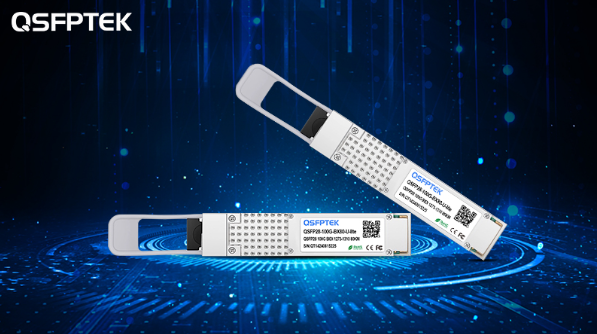Introduction
High-speed networking is no longer confined to short distances. Enterprises, telecom carriers, and data centers increasingly need 100G connectivity across tens of kilometers. Enter the 80km QSFP28 BIDI module: a single-fiber, bidirectional solution designed for long-haul Ethernet. By combining efficiency, simplicity, and reach, these modules address a growing need for high-capacity links over limited fiber infrastructure.
QSFP28 BIDI Technology in Depth
QSFP28 BIDI modules achieve full-duplex communication over a single fiber by using two distinct wavelengths. Typically, 1270nm and 1330nm wavelengths are paired to send and receive data simultaneously. By multiplexing four 25G lanes within the QSFP28 form factor, BIDI delivers 100G throughput over a single fiber strand.
This method drastically reduces fiber consumption. In traditional duplex deployments, two fibers per 100G link are required. With BIDI, operators effectively halve fiber usage, which can be critical in urban areas, older campus networks, or leased fiber segments where availability is limited.
Advantages Over Traditional Long-Haul Solutions
Historically, long-haul 100G connectivity required coherent optics or multiple fibers for parallel transmission. These approaches were costly and complex. 80km QSFP28 BIDI modules simplify deployment, reduce costs, and minimize operational overhead. They eliminate the need for additional transponders or amplifiers in most metro and regional deployments, while still supporting digital diagnostics for proactive monitoring.
The compact QSFP28 form factor ensures easy integration into existing network switches and routers. Hot-swapping capability, low power consumption, and wide interoperability make BIDI modules a practical choice for dense data center racks and central office environments.
QSFP28 BIDI Real-World Use Cases
One deployment example is connecting regional enterprise offices separated by 60–70 kilometers. By using a single strand per link, network teams can achieve high-speed, full-duplex 100G communication without overhauling existing fiber.
Another scenario involves metro network providers. Businesses demand guaranteed bandwidth, but dark fiber may be scarce. BIDI modules enable providers to meet SLAs using fewer fibers, reducing operational complexity and enhancing scalability.
Cloud and hyperscale data centers also benefit. Many data centers operate multiple sites within a city or region. Deploying 80km BIDI modules allows high-capacity interconnects without the expense of laying new fiber or upgrading to coherent 100G solutions.
100GBASE-BX80U Technical Considerations
While BIDI simplifies fiber management, engineers must pay attention to optical budgets. Long spans, connector quality, and splices can introduce loss. Proper fiber cleaning, insertion loss verification, and adherence to module specifications are essential for reliable operation.
100GBASE-BX80U BIDI modules typically offer 4–5W power consumption, manageable in dense racks. QSFP28 form factor ensures seamless integration, and Digital Optical Monitoring (DOM) provides real-time metrics for proactive network management.
Market Adoption
The demand for BIDI optics has grown steadily due to urban fiber limitations, cost considerations, and the need for scalable 100G connectivity. Third-party vendors such as QSFPTEK provide compatible, cost-effective modules, broadening accessibility for enterprises and service providers.
Future Outlook
As network speeds increase, 100G BIDI will remain relevant for legacy fiber infrastructure and transitional deployments. Operators can deploy long-haul links today without committing to costly upgrades, while preparing for higher-speed 400G and beyond in the future.
Conclusion
80km QSFP28 BIDI modules provide a strategic advantage in high-speed networking. By combining bidirectional operation, extended reach, and fiber efficiency, they enable reliable 100G connectivity over long distances. Whether for enterprise campuses, metro networks, or regional service providers, BIDI modules offer a practical, cost-effective solution for today’s bandwidth demands.


